Art of the Soviet Era
Collection donated by Ann and Joel Reed, 2021
In 2021, accomplished collectors Ann and Joel Reed donated 12 pieces of art from the Soviet impressionism and Socialist realism periods to UC San Diego. This extraordinary gift, following many years of sustained generosity and partnership with the School of Arts and Humanities, is now installed in the Arts and Humanities Building to benefit all those learning and working in our community.
If you would like to view the works in person, please contact us directly via email.
The gifted works are by 12 diverse artists and span 55 years from 1949 from 2004. They represent a rich cultural, artistic and historical record of everyday Soviet and Russian life. The Reeds and the UC San Diego School of Arts and Humanities share a goal of offering direct access to these works as a means for more closely engaging our community in the arts, and to enhance future scholarship.
The Reed family are loyal supporters of the university’s educational mission through gifts like this collection, endowed funds for creative and academic enhancement, and the expertise and insight they contribute as leaders in the community. The family began collecting Soviet-era paintings after moving to California in the mid-1990s. With this gift, they are expanding collective understanding of the cultural heritage of the former Soviet Union countries.
The guide below groups paintings by general theme: women, nature, and workers and village life.Women
Takya
Takya (1968, oil on board)
Arkadi Aleksandrovich Plastov (1893–1972)
Arkadi Plastov was one of the Soviet Union’s most celebrated painters, and widely considered one of the greatest Russian artists of all time. Plastov was awarded the Stalin Prize in 1946 and two orders of Lenin, the highest civilian award of the Soviet Union. “Takya” is representative of Plastov’s creative interest in peasant life and reflects his uncanny ability to convey human warmth and character.
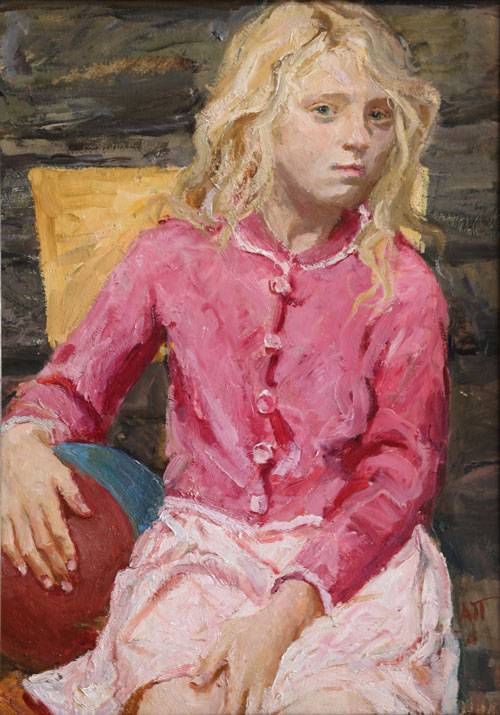
Girl with Apple
Girl with Apple (1949, oil on canvas)
Antonina Fyodorovna Sofronova (1892–1966)
Antonina Fyodorovna Sofronova enjoyed wide acclaim in the years before and immediately following the Russian Revolution of 1917. In 1914, her work was exhibited in Moscow at the Knave of Diamonds exhibit with fellow artists including Georges Braque, Kazimir Malevich and Pablo Picasso — a group alternately referred to as Jack of Diamonds. Ultimately, Sofronova’s turn to impressionism alienated her from official Soviet institutions, and she retreated to isolation.
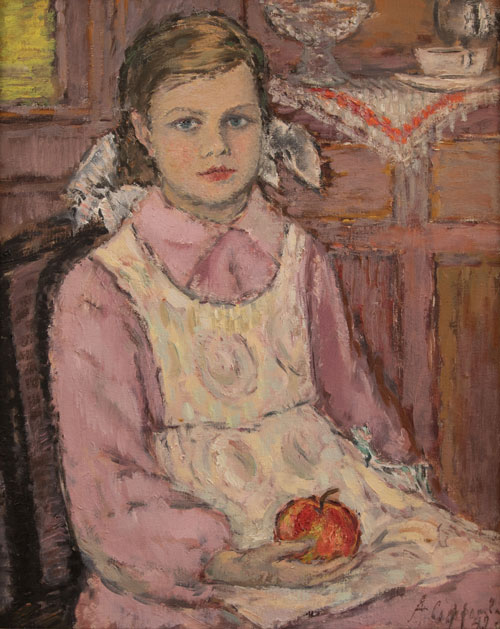
Young Girl with Apple
Young Girl with Apple (circa 1960, oil on board)
Vasili Kirillovich Nechitailo (1915–1980)
In the variety of careers represented in the collection, Vasili Nechitailo represents the pole of those whose close alignment to Soviet theory and aesthetics resulted in steady state support throughout his life. “Young Girl with Apple” offers an intimacy that is an outlier for Nechitailo’s art. He was awarded the I.E. State Repin Prize in 1971 and named Peoples’ Artist of Russia in 1965.

Slovak Girl
Slovak Girl (2004, oil on board)
Petr Pavlovich Ossovski (1925–2015)
Petr Ossovski was a founder of the severe style movement of Russian painting, characterized by an unvarnished truthfulness, grittiness or aloofness. It represents a reaction against Soviet preference for didactic narratives, and a turn in the late- and post-Soviet period to depicting bleak realities as they were. “Slovak Girl” departs from harsher realities and instead brings out vivid colors as a contrast to the subject’s pensive look.

Nature
Evening in an Aspen Forest
Evening in an Aspen Forest (1955, oil on canvas)
Ivan Ivanovich Chekmasov (1901–1961)
While “Evening in an Aspen Forest” may not appear subversive to contemporary audiences outside the former Soviet Union, its focus on landscape risked stern disapproval by the state for its lack of positive content. Given this context, its existence and preservation until after the end of the Soviet Union is a rarity. Ivan Chekmasov’s biography is correspondingly quiet, lacking the official honors shared by many of his similarly masterful peers.
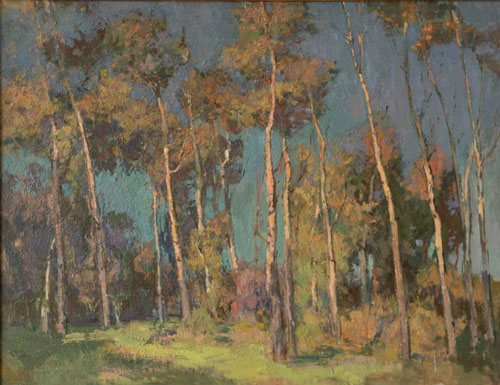
Watering Place in the Evening
Watering Place in the Evening (1983, oil on board)
Aleksei Petrovich Tkachev (b. 1925)
Most often known for collaborative creation with his brother Sergei Petrovich Tkachev, Aleksei Tkachev was awarded the title Peoples’ Artist of the Russian Federation and was a recipient of the I.E. Repin State Prize. Through the 1950s and 60s, Tkachev was known as a leading realist painter. Mastery of colored shadows and bright reflections earned the Tkachev brothers recognition as Soviet impressionists.
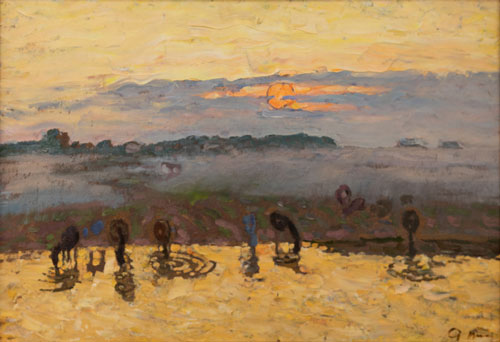
Big Water
Big Water (1966, oil on board)
Vladimir Fedorovich Stozharov (1926–1973)
Vladimir Stozharov traveled extensively through the north of Russia to study and learn the essence of peasant life. His paintings focused on elements of village architecture and the artifacts of rural experience, celebrating tradition. His work was exhibited in more than 60 museums across the Soviet Union, and he was awarded the I.E. Repin State Prize in 1968 for his regionally focused landscapes.
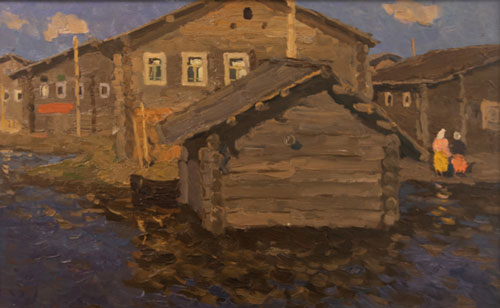
Frosty Morning
Frosty Morning (1963, oil on board)
Nikolai Efimovich Timkov (1912–1993)
A member of the Leningrad School, Nikolai Timkov was known as one of the first Soviet artists and landscape painters. His use of the impressionist palette and brushwork was at its strongest in paintings of wintry conditions, such as “Frosty Morning.” He served in the Baltic Fleet during the Great Patriotic War (World War II), and during visits to Leningrad prepared a series of graphic works depicting the siege of Leningrad. His focus on landscapes reflected lifelong attention to form, color and shapes in nature as both decoration and subject.

Workers and Village Life
Friends
Friends (1964, oil on canvas)
Valerian Mikhailovich Formozov (1921–2004)
Born in Tepelevo, in Russia’s Gorky region, Valerian Formozov became a Red Army soldier in 1940 and served in the Great Patriotic War (World War II). He was awarded the Patriotic War Order for his valor and received a number of medals. War preoccupied Formozov through his artistic career as he sought to understand its impact on himself, other soldiers and recovering villages. His paintings contrast hardship with colorful patterns and the simple, serene existence of village life.
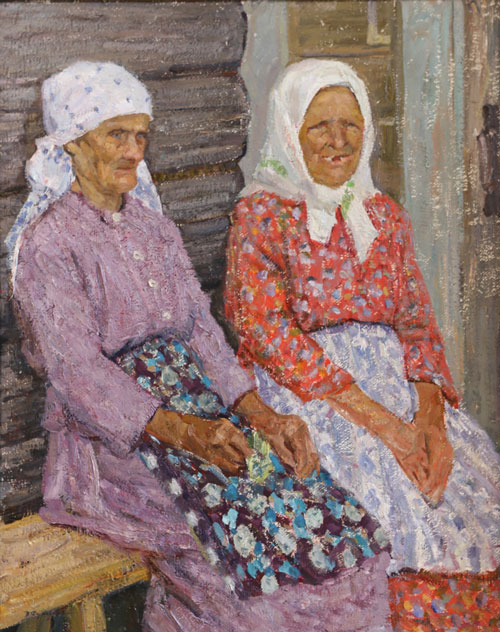
Tomato Picking
Tomato Picking (1949, oil on canvas)
Zinaida Mikhailovna Kovalevskaya (1902–1972)
Zinaida Kovalevskaya was recognized as a leading realist in Uzbekistan, where she helped set up and run the first art school in Samarkand, and was awarded the title Peoples’ Artist of Uzbekistan in 1964. “Tomato Picking” provides a unique combination of the hallmark movements of the era, interjecting Soviet realism into a work that in formal terms exemplifies Soviet impressionism. Depicting the abundance of the harvest and happiness of the people, Kovalevskaya celebrates the strength of Soviet workers.
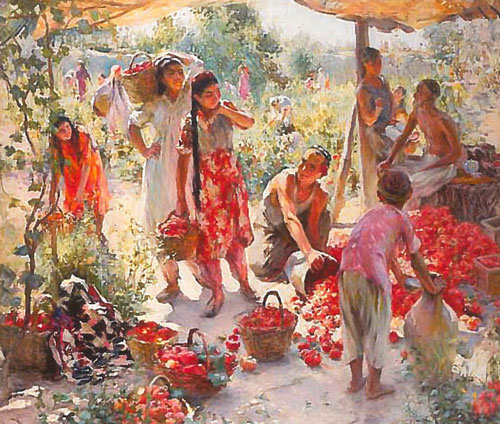
Builders of the G.E.S. Brotherhood
Builders of the G.E.S. Brotherhood (1961, oil on canvas)
Viktor Efimovich Popkov (1932–1974)
Although his life was short, Viktor Popkov lived an intensely influential life and is considered one of the most remarkable artists of his generation. His paintings are known for their dramatic tension, social themes and insight into persons and situations. “Builders of the G.E.S. Brotherhood” is the final finished study for the painting “The Builders of Bratsk,” now on display in the Tretyakov Gallery Collection in Moscow. The study is an exemplar of a common focus on Soviet workers in the 1950s and 60s, more somber in demeanor than the exuberant subjects in earlier years.
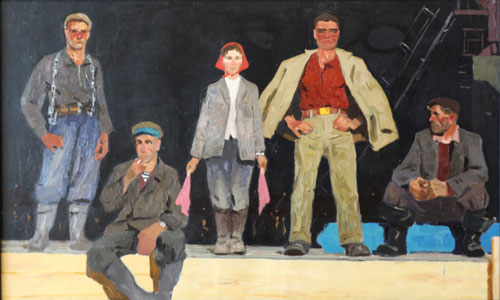
Self Portrait
Self Portrait (1952, oil on board)
Geli Mikhailovich Korzhev-Chuvelev (1925–2012)
During his time, Geli Kozhev was praised as Russia’s greatest living artist. He characterized himself and his peers as the “war generation,” with the subject of war being one of the key themes of his art. His “Self Portrait” of 1952 was painted in the years before he created these more widely appreciated works, a self-meditation linking his legacy to the other great impressionists of the time.
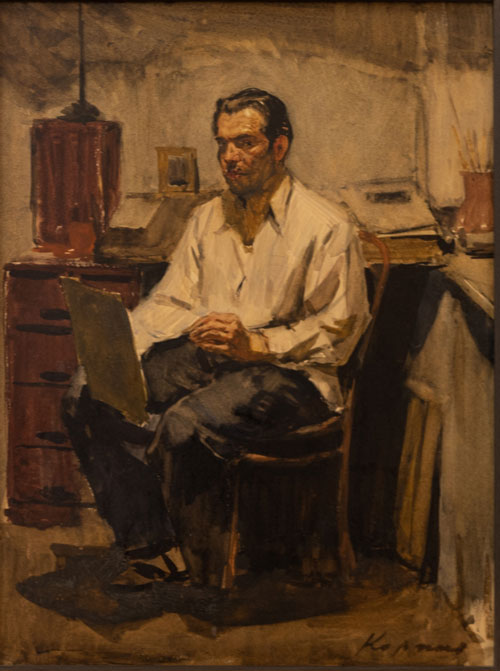
The 12 paintings in the collection represent two artistic movements: Soviet Impressionism and Socialist Realism.
The Soviet impressionism period lasted from approximately 1930 to 1980. Instead of incorporating the twentieth-century Western artistic sensibilities, impressionists in Russia celebrated the common people, intimately depicting their lives, hopes, dreams and emotions. These artists focused deeply on the land, people and social experiments of the time with the goal of enriching the lives of all people.
Socialist realism was the officially sanctioned style of art that dominated Soviet painting for 50 years beginning in the early 1930s. The state defined the style and content to advance the goals of socialism and communism. The result was an immense body of work by thousands of artists, much of which has been rejected by Western critics; however, among this work were some artists who created interesting and original art within the structures of Socialist realism.
Read and review the sources for the historic notes and artistic scholarship summaries (PDF)
